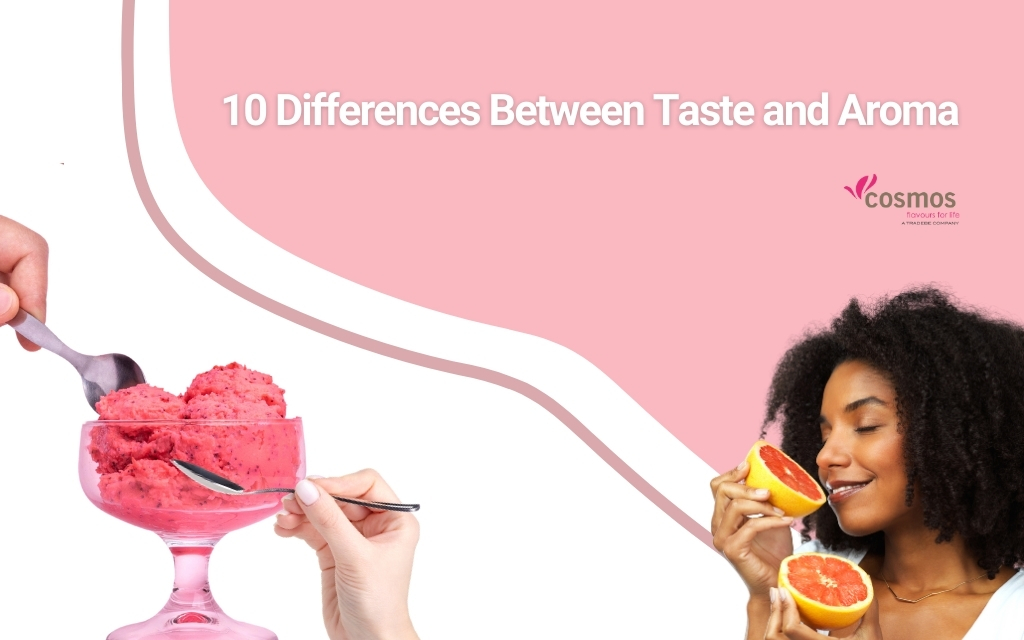In the fascinating world of taste and aroma, understanding the differences between these two concepts can help us better appreciate the complexities of food and drink, enhance our culinary experiences, and boost our creativity in the kitchen.
This knowledge not only enriches our sensory appreciation but also plays a crucial role in product development, the marketing generated around it, and the consumer experience. In this article, we unravel the key differences between taste and aroma.
Basic Concepts
What is Taste?
Taste is a complex perception that arises from the combination of three senses: taste, smell, and touch. It originates when compounds in foods interact with taste buds on the tongue, generating basic sensations such as sweet, salty, bitter, sour, and umami.
What is Aroma?
Aroma, on the other hand, is perceived through the sense of smell and originates from the volatile compounds released by foods or drinks, reaching the nose. It is more complex and varies greatly, significantly contributing to the complete sensory experience of a food or drink.
How Taste and Aroma Interact
Taste and aroma closely interact to create the complete perception of a food or drink. As we eat or drink, aromatic compounds are released and travel to the retro-nasal cavity, where they combine with taste sensations, creating a rich and complex sensory experience.
Chemical Components of Taste
Tastes derive from a combination of molecules present in foods, including sugars, acids, salt, and amino acid compounds, which interact with the taste buds.
Chemical Components of Aroma
Aromas come from a wide range of volatile compounds that, when inhaled, stimulate the olfactory receptors in the nose, sending signals to the brain that are interpreted as different aromas.
The Role of Taste Buds
Taste buds are the primary sensors of taste, distributed along the tongue. Each contains taste cells that respond to the different basic tastes.
Influence of Genetics on Taste Perception
Genetics play a crucial role in how we perceive tastes. For example, some people have a higher sensitivity to bitter tastes due to specific genetic variations.
How Smell Processes Aromas
The olfactory system transforms the chemical signals from volatile compounds into aroma perceptions. This process involves a complex interaction between the olfactory receptors in the nose and the brain.
The Emotional and Memory Impact of Aroma
Aromas have a strong connection with emotions and memory, more so than any other sense. They can evoke intense memories and feelings, demonstrating their powerful influence on our experiences and behaviors.
Key Differences Between Taste and Aroma
Difference 1: Sensory Perception
Taste is primarily perceived through the tongue, while aroma is perceived through the sense of smell. This distinction is fundamental to understanding how we experience food and drinks.
Difference 2: Chemical Compounds
While basic tastes are relatively limited and originated by specific compounds, aromas can come from thousands of different volatile compounds, offering a much wider range of perceptions.
Difference 3: Role in the Tasting Experience
Aroma can play a more significant role than taste in the tasting experience, due to its complexity and ability to evoke memories and emotions.
Difference 4: Influence on Food Preference
Both taste and aroma influence our food preferences, but aroma has a more direct influence on our perception of the quality and freshness of foods.
Difference 5: Cultural Variations
Perceptions of taste and aroma vary significantly between cultures, influenced by diet, genetics, and shared sensory experiences.
Difference 6: Time of Perception
Taste perception occurs almost immediately upon contact with the tongue, while aroma requires the inhalation of volatile compounds, which can take more time.
Difference 7: Changes with Age
Sensitivity to taste tends to decrease with age, while the perception of aroma can remain more constant, affecting how older people experience foods.
Difference 8: Modification and Enhancement
It is easier to modify and enhance aromas using culinary and technological techniques than to change the basic flavours of foods.
Difference 9: Impact on Satiety
Aroma can affect the perception of satiety and satisfaction after eating, while taste has a more direct impact on the decision to continue eating.
Difference 10: Contribution to Product Identity
Aroma can define the identity of a food product or drink more distinctively than taste, due to its complexity and ability to evoke unique associations.
Practical Applications in the Industry
Knowledge of the differences between taste and aroma is crucial for professionals in the flavour and aroma sector. This understanding allows for innovation in product development, the creation of more effective marketing strategies, and an improved consumer experience. From designing new foods and drinks to creating unique gastronomic experiences, the science of taste and aroma opens a world of possibilities for enriching our sensory world.
Conclusion
Differentiating between taste and aroma is essential for any professional in the development of flavours and aromas. These differences not only affect how we experience food and drinks but also have practical implications in the industry. Understanding these distinctions allows us to explore new dimensions in the creation of products and sensory experiences, enriching the everyday lives of consumers around the world.










